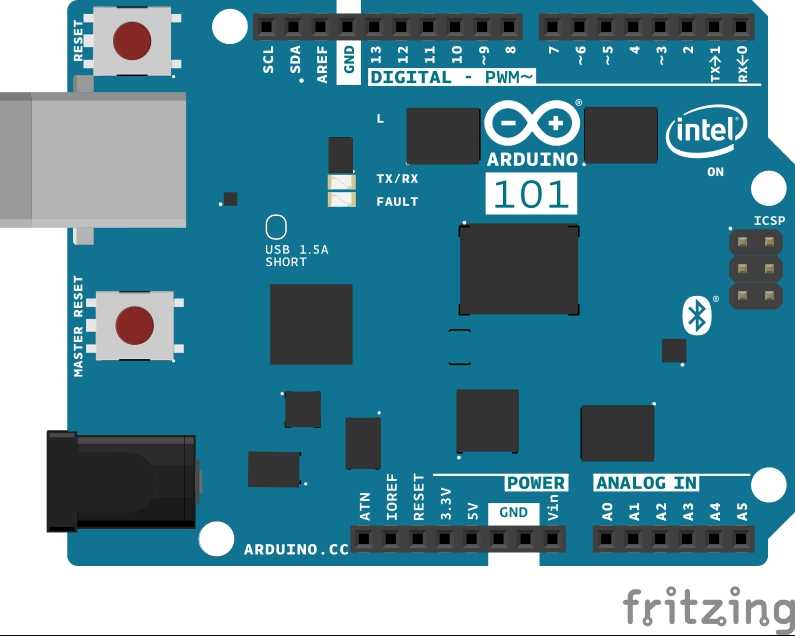Arduino 101 Curie Timer One Interrupt
With this tutorial you learn to use one of the timers available in the microcontroller. The library uses Timer 1 and this tutorial shows how to set up an interrupt at variable intervals to toggle the on-board LED. The interrupt is the only way to exit from a delay() function and it is used in this sketch to show how a delay instruction - that apparently stops the flow of the code execution - is temporarily exited to toggle the LED, then it is continued from where it was interrupted. The final effect is a 10 seconds blinking block with the same blinking rate, incremented every 10 seconds in four steps.
Hardware Required
The Circuit

image developed using Fritzing. No additional hardware is needed to use this tutorial.
Software Essentials
Libraries
CurieTimerOne.h is the library that provides access to the Timer 1 of the microcontroller. This library allows to set up the number of microseconds that the timer counts before it asserts an interrupt. The interrupt can be configured to call a specific function - the callback function - and each interrupt increments a counter. The same library is used to generate a PWM signal with duty cycle and period lenght fully customizable.
Functions
timedBlinkIsr() - is the function to which the sketch execution is passed when the interrupt is asserted. It toggles the state of the LED on D13 using the toggle variable that is changed using the "!" (NOT) operator at each call.
Code
The code is written with a serial monitor feature that can be toggled commenting or uncommenting #define SERIAL_PORT_LOG_ENABLE 1.
/*
Sketch: Timer1Interrupt.ino
This sketch demonstrates the usage of the Curie Timer One Library.
It uses timer-1 to blink the onboard LED, pin 13, at different
intervals (speed) in four steps.
You can see the time interval and the number of interrupt counted
in 10 seconds if you keep serial logging active, but this may require
a MASTER_RESET to reprogram the board.
Blinking of the LED will start only when you open the Serial Monitor
unless you comment the "#define SERIAL_PORT_LOG_ENABLE 1"; don't
forget to uncomment "CurieTimerOne.restart(time);"
created by Intel
Modified 14 March 2016
by Simone Majocchi
This example code is in the public domain.
*/
#include "CurieTimerOne.h"
// Comment the following statement to disable logging on serial port.
#define SERIAL_PORT_LOG_ENABLE 1
const int oneSecInUsec = 1000000; // A second in mirco second unit.
bool toggle = 0; // The LED status toggle
int time; // the variable used to set the Timer
void timedBlinkIsr() // callback function when interrupt is asserted
{
digitalWrite(13, toggle);
toggle = !toggle; // use NOT operator to invert toggle value
}
void setup() {
#ifdef SERIAL_PORT_LOG_ENABLE
Serial.begin(115200); // initialize Serial communication
while (!Serial); // wait for the serial monitor to open
#endif
// Initialize pin 13 as an output - onboard LED.
pinMode(13, OUTPUT);
}
void loop() {
for (int i = 1; i < 9; i = i * 2) {
// We set a blink rate of 1000000, 500000, 250000, 125000 microseconds
time = oneSecInUsec / i; // time is used to toggle the LED is divided by i
CurieTimerOne.start(time, &timedBlinkIsr); // set timer and callback
#ifdef SERIAL_PORT_LOG_ENABLE
Serial.print("The blink period: ");
Serial.println(time);
#endif
delay(10000); // 10 seconds of delay, regularly 'interrupted' by the timer interrupt
#ifdef SERIAL_PORT_LOG_ENABLE
Serial.print("Total number of ticks in 10 seconds: ");
Serial.println(CurieTimerOne.rdRstTickCount()); // Reads and Resets tick count
Serial.println("----");
#endif
// Uncomment the following line if the serial logging is disabled
// CurieTimerOne.restart(time); // Restarts Timer
}
}See Also
Last revision 2016/03/13 by SM